Steph W. from SEOPressor


...help you check your website and tell you exactly how to rank higher?


87
score %
SEO Score

Found us from search engine?
We rank high, you can too.
SEOPressor helps you to optimize your on-page SEO for higher & improved search ranking.
By vivian on May 27, 2015
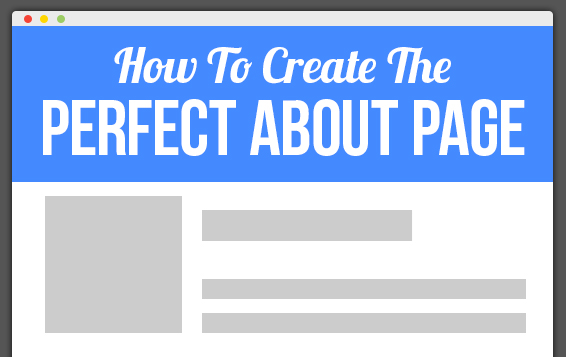
Have you ever been asked to describe yourself and find yourself speechless because you don’t really know yourself?
Well, that happens to most of us so don’t worry, you’re not alone.
Creating an about page is pretty similar to this, except it is much more complicated than this.
The about page isn’t something that most companies forget about – but it’s usually the one page that they put the least amount of effort into.
Most of the time, the about page contains a small and simple write up about the company – and most of the time, that write-up is terrible.
This is in part because people generally aren’t comfortable with writing about themselves.
There’s a thin line between sounding arrogant and being so modest that you risk sounding like you don’t know what you’re doing.
Finding a middle ground is essential. You should spend some time crafting an effective about page because it helps to not only provide your brand with an identity, it also helps you to strengthen your brand.
Below are 5 ways to create the perfect about page for your business website:

It can be easy to get lost in the visual design of your website, which results in the contact and about pages being more of an afterthought.
Don’t just write up a brief history of your company. While the about page is an opportunity to brief visitors about your company’s history, this shouldn’t take more than a paragraph to accomplish.
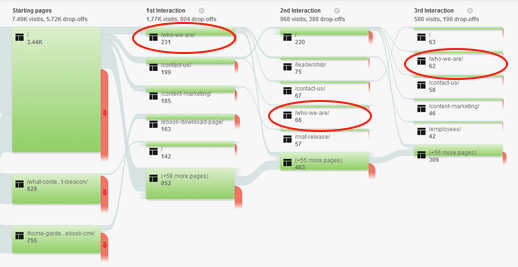
Something that many people don’t realize is that the about pages tend to be the second most visited pages on company pages after the landing page.
There’s a simple reason for this – your visitors want to confirm that you are genuine and that you are someone that they want to do business with. Because of this, authenticity is incredibly important. Because of this, you need to know who your customers are and what it is that they are looking for.
Research and analytics are vital for figuring this out. This way, your about page can answer the questions your customers have without having to be asked.
Establishing what your goals are as a business will also help you to connect with your readers. If you don’t tell your readers what the goals of the company are, they’ll just assume that your goal is to make money, which isn’t a good way to connect with your audience.
A really great example of a brand that effectively balances information about themselves with what they do for their customers is MailChimp. If you check out their about page, you’ll see that they only dedicate a couple of paragraphs to what they do and their history, while integrating how their goal is beneficial to their customers (they highlight how they love seeing businesses grow, which is why they provide products and features that help smaller businesses succeed).
They barely mention their products although they do have a header for it – it basically consists of links to their products without wasting any space trying to promote them. Instead, they focus on explaining what their work culture is like as well as how they support their community – two things that help make their company more personal and relatable.
Related link:

Getting the right tone of voice in your about page is crucial. The right tone of voice will amplify the content of your about page and differentiate you from the rest.
To do this, you need to decide what kind of brand you are, identify what tone of voice you should use. Whether your tone of voice is friendly, sassy, funky, serious, or confident, it should suit your brand and it’s values.
This means that if you run a law firm, the last voice you should use is one with a funny or sassy tone. A more appropriate tone would be serious and confident.
In addition to finding the right tone of voice of your brand, you need to make sure that it’s consistent over all platforms – meaning that your blog should be written in the same voice, as should all the posts that you make on your social media channels. If you don’t use the same voice, your readers are going to get confused and you’ll end up weakening your brand identity.
You should also avoid writing in the third person as this will create distance between you and the reader. You don’t want the reader to read about a company, you want them to read about you.
The perfect about page for business websites should be written in the first person. By writing in the first person, you’ll make it much easier for your readers to connect directly with you. It’s more personal, which, therefore makes your story more relatable. Directly address the reader as “you” and refer to your company as “we” or “us.”
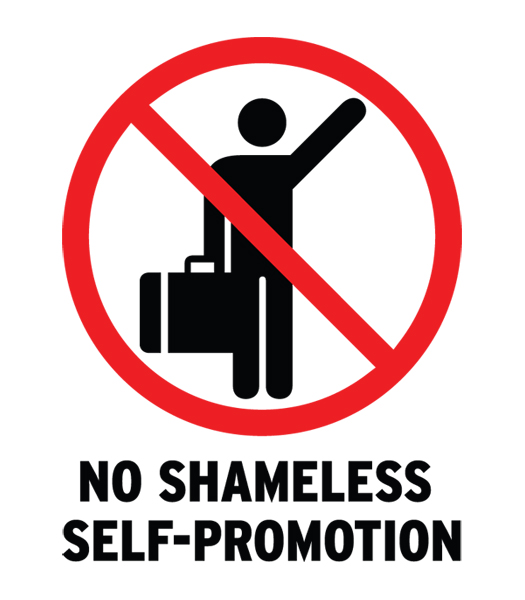
The point of a perfect about page for business websites is to build a relationship with your audience, it’s not about trying to sell products or services.
There’s nothing wrong with making your reader aware of what your products and services are, you just don’t want to implement some sort of sales pitch in your about page.
There’s a pretty good chance that your audience will check out your products and services after they’ve read through your about page. And besides, odds are pretty good that there are plenty of places on your website where they can obtain information about your products or services.
The last thing your audience wants to read through when they click on your about page is what amounts to yet another advertisement – it’s a turn off actually.
However, even though you should avoid trying to sell your products and services, the about page is a good opportunity to suggest to your readers to subscribe to updates. If they like what they read on your about page, they may be more willing to opt-in to a newsletter, especially if the content on your about page is of high quality and indicative of what your email content will be like.
At this point, it should be obvious that visual content is more attractive to Internet users than text. It’s why pictures are shared so often on social media sites.
This means that images are an absolute must for anyone trying to create the perfect about page for business websites.
However, this isn’t the only reason to use images. Images are a fantastic way to make your brand more relatable to readers. For example, photographs of your company’s leaders and employees help put a face to the brand.
A law firm might want to have photographs of the partners wearing suits. An energy drink company may want to have some images of the founding members wearing casual clothing, maybe even participating in a sport.
Behind the scenes images are quite effective as well since they invite readers into the company for what feels like a privileged tour. Images help provide context to your story and can go a long way in helping to strengthen your brand’s identity.
Just remember, the images you use represent your brand’s image in the same way that the voice you use represents you.
This means that posting images of your law firm’s partners having a few beers at a barbecue dressed in cargo shorts and sandals is probably not the most appropriate idea.
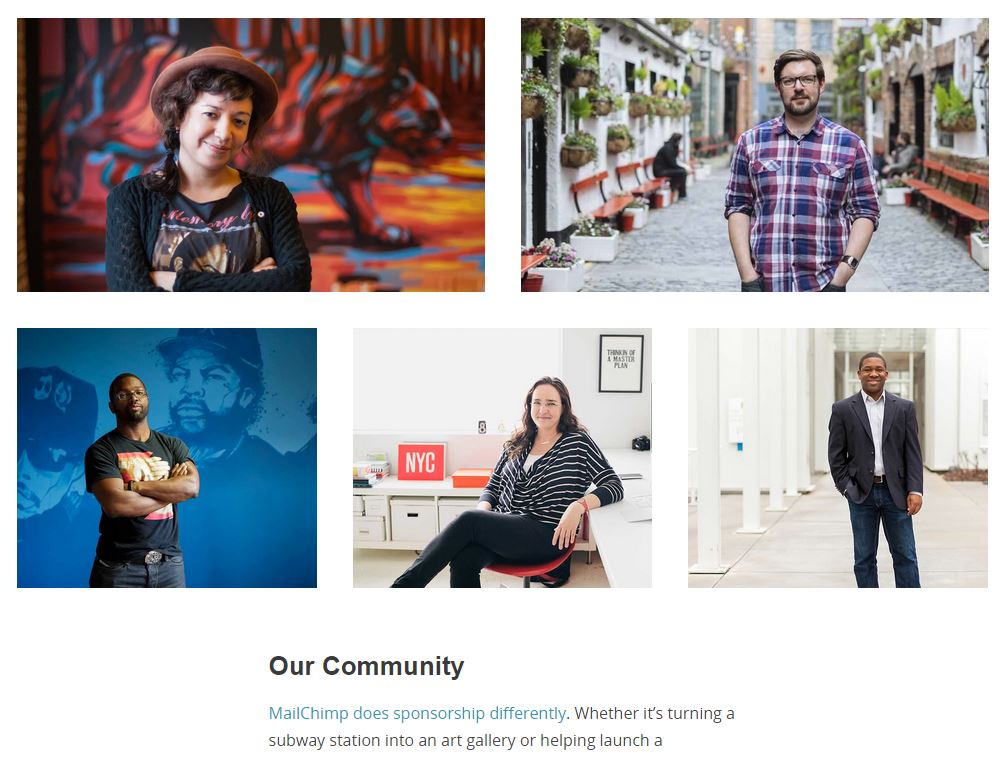
Check out MailChimp again to see how images can be used to great success. They use small portraits of their team members to break up the different sections of their about page. They are obviously professionally taken photographs depicting smiling team members, wearing casual clothing for the most part – albeit still looking clean and professional.
MailChimp creates the feeling that they are an enjoyable but still professional place to work, which is a positive impression to give to readers.
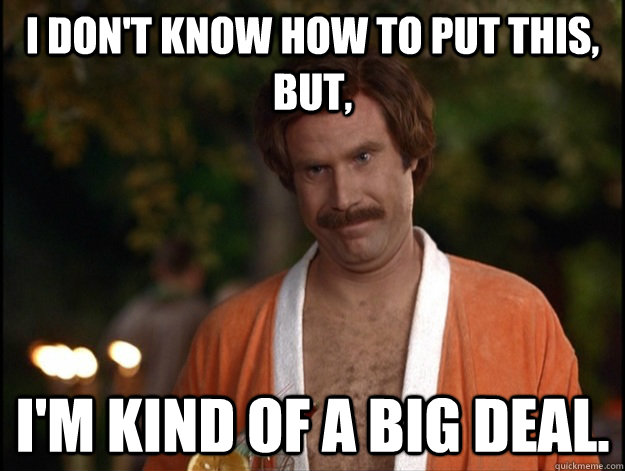
Remember how we mentioned trying to find that middle ground between sounding too arrogant and sounding too humble? This middle ground is known as the “humblebrag”. Basically, you want to use your about page to brag about your company in as humble a way as possible. This may seem impossible, but it’s not!
One of the most effective way to do this is by using customer testimonials. What better way to show off than have someone else brag about you? This way you don’t come off as arrogant since you are letting your customers speak on your behalf.
Customer testimonials are a great way to build trust and credibility among your readers as well since consumers are more likely to trust the word of other consumers than they are to trust the word of the company that’s trying to sell something to them.

For a great example of how to use customer testimonials, visit the ChowNow’s page. Their testimonial is shown upfront and center, featuring a powerful one liner and complemented by the full video testimonial.
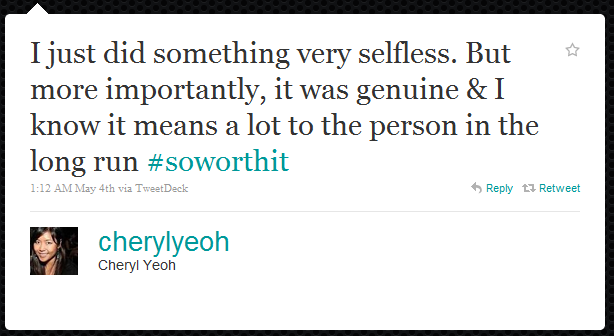
Humblebragging is an artform, and Cheryl is definitely not getting it.

Sometimes, humblebragging can get really ugly.
Don’t dismiss the importance of creating the perfect about page for your business website. The about page has a huge impact on your brand’s identity and your audience’s ability to relate to your company on a more personal level. Make sure that you implement these tips to create the perfect about page for business websites.
Let us know if you have any other tips on creating the perfect about page in the comment section below!
Related Links:
[This blog post was originally written and published by Zhi Yuan on May 26, 2015. It is most recently updated by Howard Go on Jun 02, 2020]
Updated: 9 December 2025


Save thousands of dollars (it’s 100x cheaper)

Zero risk of Google penalty (it’s Google-approved)

Boost your rankings (proven by case studies)
Rank High With This Link Strategy
Precise, Simplified, Fast Internal Linking.
